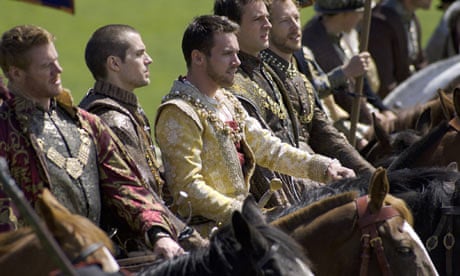"Shame on the BBC!" yelled David Starkey when The Tudors began, outraged by what he saw as systematic inaccuracy. But as the Henry VIII saga reaches its final episode tomorrow night, fusty dons such as Starkey should be running scared – because the drama has exploded one historical bombshell after another, and has taught us that almost everything we thought we knew about Henry VIII was wrong.
Weight
Henry never became fat. Paintings depicting him in this way presumably used bulk as a propaganda symbol of greatness. The king also still looked 30 when in his 50s.
Accent
Nor did he speak in the fruity roar actors such as Charles Laughton and Keith Michell have duped us into imagining. Instead, Jonathan Rhys Meyers's definitive performance shows he had an oddly jerky vocal style, like a Rada-trained robot or Basil Brush channelling Laurence Olivier. The future monarchs Edward and Elizabeth also had, it seems, faint but discernible Irish accents, calling into doubt both their parentage and the legitimacy of the Tudor dynasty. Similarly, Catherine of Aragon was not Spanish judging by her tourist-style efforts to speak the language, slyly posing the question: if she was an impostor, was the whole business of seeking a papal annulment and turning England Protestant unnecessary?
Appearance
Our sense of how people looked in the 16th century will have to be radically revised as a result of the series' research. Courtiers' skin was flawlessly smooth, teeth met Hollywood standards of whiteness and evenness. The era's hairstyles lent men the look of boyband members (until they turned 30, when obligatory beards made them more like country or easy-listening artistes), while in all but clothes women resembled characters in Gossip Girl or Desperate Housewives.
Sex
Historians of sex must now be scrambling to rewrite their accounts too, as only prostitutes, plus the odd debauched Roman orgy-goer, are conventionally seen as engaging in anything other than the missionary position before 1960. As The Tudors has revealed, young aristocratic women at Henry's court were well-versed in other erotic options, and not afraid (see Anne Boleyn below) of initiating them on a first date.
Given that Starkey fronted Channel 4's The Six Wives of Henry VIII, Starkey will have been particularly piqued that a drama he slated as "soap" offered insights into the dynamics of the king's relationships that made his own efforts look stuffy and old hat. It is now beyond dispute, for example, that Anne Boleyn won the royal heart by giving him a blow job during the Anglo-French festivities of the Field of the Cloth of Gold; and that Anne of Cleves's main sexual drawback was not that she looked like a "Flanders mare", or possibly a girl-next-door soul singer enduring a career slump, but that she was very smelly. In another scholarly breakthrough, the pair were shown as sleeping together post-divorce, presumably after Anne had received guidance on hygiene and grooming.
The weather
Weather in Tudor times has also previously been misrepresented. What is now clear is that it was always fine in London – allowing sunlight to stream through a single stained-glass window whenever the king held audiences – except on days of beheadings and burnings. Northern England, Scotland and northern France, in contrast, knew only rain, grey skies or smoke.
Popes
Not only English history will now have to be revised. Among the series' scoops is that Pope Paul III (played by Peter O'Toole), rather than Clement VII, was Henry's opponent in the annulment battle (the drama picked "the wrong pope!", historians splutter vainly, knowing their collective lie can no longer be kept up); and that – in an episode shamefully covered up in official Iberian chronicles, which fail even to mention the marriage – the king's sister Margaret was sent to Portugal to wed doddery Manoel I and wasted no time in suffocating him with a pillow.
Speech
The way in which people at Henry's court spoke, particularly in informal contexts, was far more "modern" than we've previously been led to believe. And many phrases we thought were coined in the past 20 years were in fact first said almost five centuries ago. Catherine of Aragon was told she was "the queen of hearts". Anne Boleyn complained "you can't have three people in a marriage". Catherine Howard was prone to say "oh my God!"
Catherines
For kings or future kings, marrying a Catherine is seriously unwise (Aragon, Howard), unless you marry one when you're too old and sick for sex (Parr).
These are only the most obvious of the series' stream of revelations. What did we miss? Let us know in the comments below

Comments (…)
Sign in or create your Guardian account to join the discussion